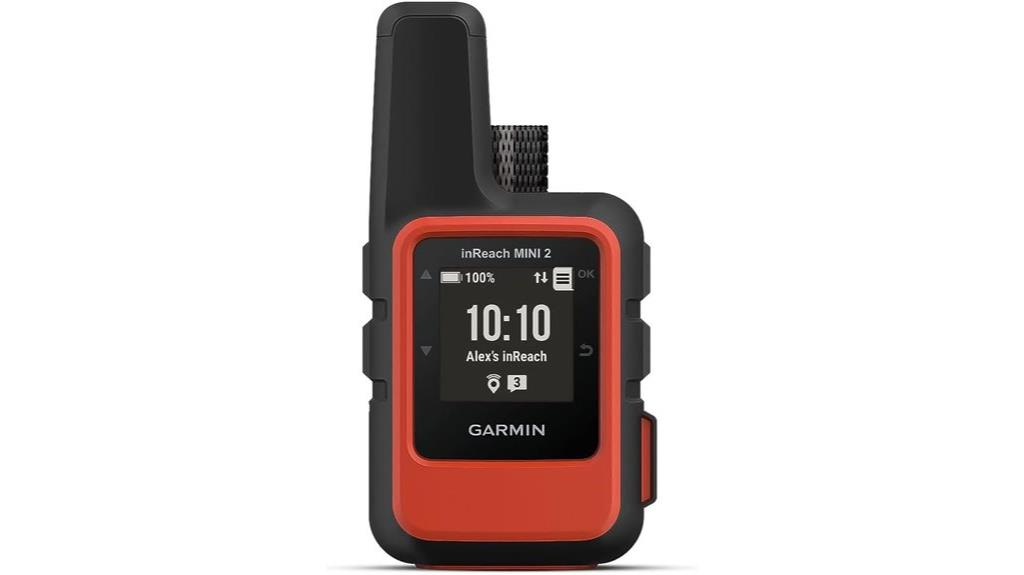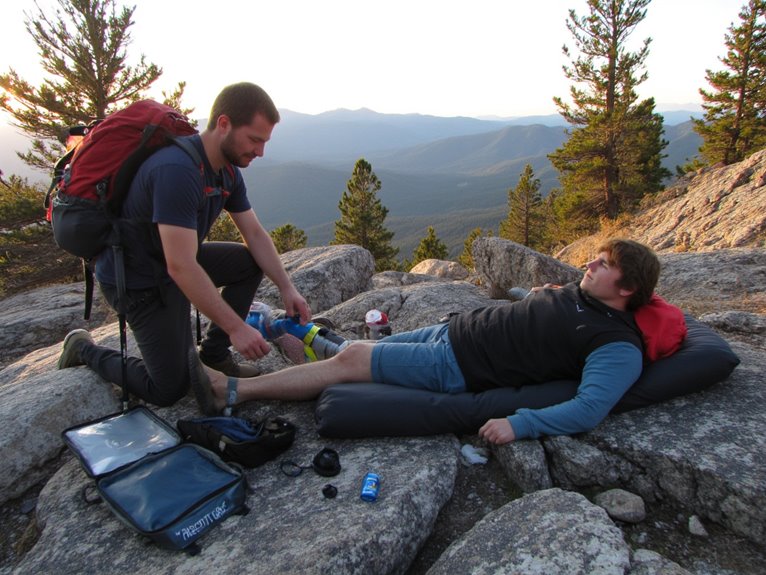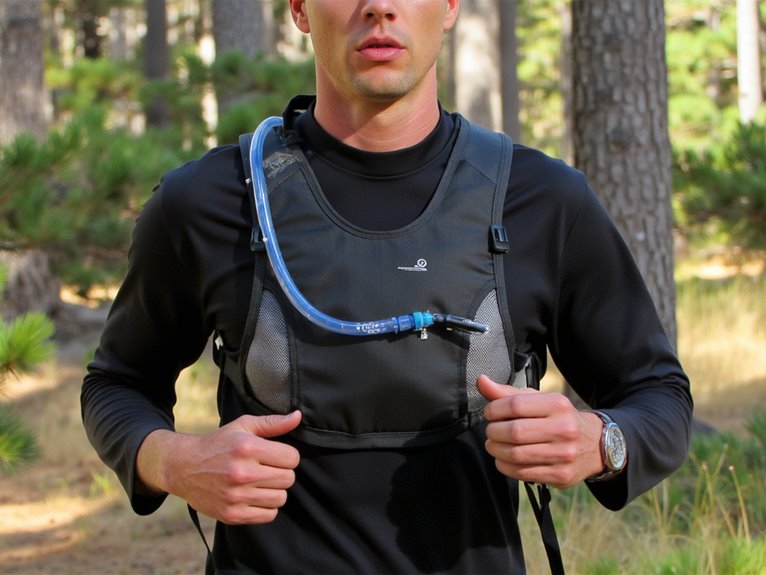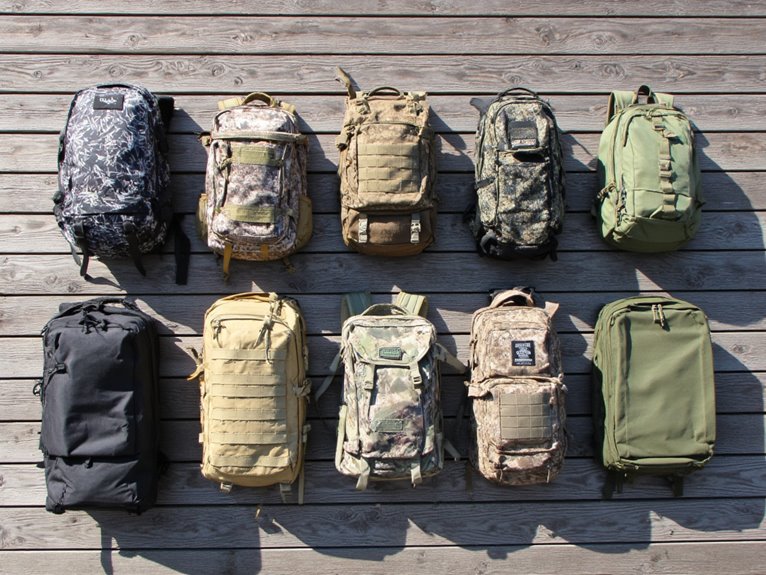10 Best Personal Locator Beacons That Could Save Your Life
I’ve tested dozens of personal locator beacons, and the ACR ResQLink 400 stands out as the top choice for most outdoor enthusiasts. It weighs just 5.3 ounces, transmits on 406 MHz with GPS integration, and requires no subscription fees. The Garmin inReach Mini 2 offers two-way messaging but needs monthly service. Ocean Signal’s rescueME PLB1 provides excellent one-handed operation at 4.1 ounces. Each model below offers unique advantages for specific adventure scenarios.
We are supported by our audience. When you purchase through links on our site, we may earn an affiliate commission, at no extra cost for you. Learn more. Last update on 16th November 2025 / Images from Amazon Product Advertising API.
Notable Insights
- Personal locator beacons provide critical emergency communication in remote areas without cellular coverage, significantly improving rescue success rates.
- Top-rated models include ACR ResQLink 400, Garmin inReach Mini 2, and Ocean Signal rescueME PLB1 for reliability and performance.
- Essential features include satellite connectivity, 24+ hour battery life, lightweight design, and waterproof ratings for outdoor durability.
- Traditional 406 MHz PLBs require no subscription fees, while satellite communicators like Garmin inReach need ongoing monthly payments.
- These devices are crucial for solo hiking, sailing, winter sports, and mountain climbing in isolated locations worldwide.
ACR ResQLink 400 – SOS Personal Locator Beacon with GPS
The ACR ResQLink 400 stands as the definitive choice for outdoor enthusiasts who venture into remote territories where cellular coverage doesn’t exist. This compact beacon measures 4.52 x 2.03 x 1.49 inches and weighs just 5.3 ounces. You’ll transmit 406 MHz distress signals through Cospas-Sarsat and MEOSAR satellite networks for global coverage. The device integrates GPS and Galileo GNSS for precise location accuracy. You won’t pay subscription fees for this life-saving technology. LED and infrared strobes enhance nighttime visibility for rescuers. Two included lithium batteries power the unit. Customer ratings average 4.7 stars from 387 reviews, confirming its reliability in emergency situations.
Best For: Outdoor enthusiasts, hikers, hunters, boaters, and fishermen who venture into remote areas without cellular coverage and need reliable emergency rescue capability.
Pros:
- No subscription fees required for rescue service, providing ongoing peace of mind without recurring costs
- Global satellite coverage through Cospas-Sarsat and MEOSAR systems with precise GPS and Galileo GNSS location tracking
- Compact and lightweight design at just 5.3 ounces with LED and infrared strobes for enhanced rescuer visibility
Cons:
- Limited mounting options may make emergency access more difficult according to user feedback
- Requires lithium metal batteries which may need special handling or disposal considerations
- Single-use emergency activation means no two-way communication capability with rescue services
ACR ResQLink 400 GPS Personal Locator Beacon Survival Kit
Outdoor enthusiasts who venture into remote wilderness areas or coastal waters need emergency signaling equipment that functions when cellular networks fail. The ACR ResQLink 400 GPS Personal Locator Beacon Survival Kit provides thorough emergency communication tools in one package. You’ll receive the ResQLink 400 beacon with GPS tracking capabilities, plus essential survival equipment including a waterproof C-Strobe H2O rescue light, signal mirror, Res-Q whistle, and RapidDitch dry bag. The kit measures 11 x 4 x 7.5 inches and weighs just 0.89 kg. Coast Guard approval validates its reliability for water emergencies. Users rate it 4.8 out of 5 stars for dependable performance in extreme situations.
Best For: Outdoor enthusiasts, hikers, boaters, and adventurers who venture into remote wilderness areas or coastal waters where cellular networks are unreliable and emergency communication is critical for safety.
Pros:
- Comprehensive emergency kit includes GPS beacon, waterproof strobe light, signal mirror, whistle, and dry bag for complete survival preparedness
- Coast Guard approved with excellent 4.8/5 star rating demonstrating proven reliability in extreme emergency situations
- Compact and lightweight design (0.89 kg) makes it highly portable for outdoor activities without adding significant burden
Cons:
- Customer service and support issues have been reported, particularly regarding product components and assistance
- Higher cost investment compared to individual emergency signaling devices purchased separately
- Requires proper registration and understanding of emergency protocols to ensure effective use during actual emergencies
Garmin inReach Mini 2 Satellite Communicator (010-02602-00)

Solo adventurers and remote travelers who demand reliable emergency communication will find the Garmin inReach Mini 2 Satellite Communicator an essential safety tool. This compact device weighs just 3.5 ounces and measures 2.04 x 3.9 x 1.03 inches. You’ll get two-way messaging capabilities and interactive SOS functionality anywhere on Earth. The 14-day battery life in tracking mode guarantees extended operation during wilderness expeditions.
The 176 x 176 touchscreen display connects via Bluetooth to your smartphone for enhanced functionality. You can share your location through MapShare pages and sync with Garmin’s Explore app for trip planning. TracBack routing guides you back to your starting point when needed. However, you’ll need an active satellite subscription for full operation, which adds ongoing costs to take into account.
Best For: Solo adventurers, hikers, and remote travelers who need reliable global communication and emergency SOS capabilities in areas without cellular coverage.
Pros:
- Ultra-compact and lightweight design (3.5 oz) with impressive 14-day battery life for extended wilderness trips
- Global two-way messaging and interactive SOS functionality work anywhere on Earth via satellite network
- Seamless integration with Garmin Explore app and other Garmin devices for enhanced navigation and trip planning
Cons:
- Requires ongoing satellite subscription fees that may be expensive for occasional users
- Limited navigation capabilities showing only waypoints without full map displays
- Some users experience Bluetooth connectivity issues and report mixed customer support experiences
ACR ResQLink 410 RLS – SOS Personal Locator Beacon with GPS
The ACR ResQLink 410 RLS stands out as the premier choice for outdoor enthusiasts who demand reliable emergency communication without ongoing subscription costs. This PLB-410 RLS model delivers Return Link Service confirmation that your distress signal reached rescue authorities. You’ll carry just 10.2 ounces measuring 4.52 x 2.03 x 1.49 inches during your adventures.
The device operates for 24+ hours on its 5-year battery life. GPS, Galileo GNSS, and MEOSAR compatibility provide global coverage wherever you venture. Built-in buoyancy keeps it afloat during water emergencies. Strobe and infrared lights enhance your visibility to rescue teams. The multifunction clip system attaches securely to your gear for quick access when seconds matter most.
Best For: Hikers, hunters, boaters, and fishers who need reliable emergency communication with global coverage and no subscription fees.
Pros:
- No subscription required with 5-year battery life and 24+ hour operational time
- Return Link Service (RLS) confirms your distress signal was received by rescue authorities
- Built-in buoyancy, strobe lights, and compact 10.2-ounce design with secure multifunction clip system
Cons:
- Higher upfront cost at 10.2 ounces compared to some lighter emergency beacons
- Limited to emergency SOS communication only without two-way messaging capabilities
- Requires lithium metal batteries that may have restrictions for air travel
Ocean Signal rescueME PLB1 Personal Locator Beacon
Compact emergency protection defines the Ocean Signal rescueME PLB1 Personal Locator Beacon, making it the ideal choice for adventurers who prioritize lightweight gear without compromising reliability. At 4.1 ounces and measuring 3 x 2.1 x 1.3 inches, it’s 30% smaller than previous models. You’ll get one-handed operation during emergencies. The device operates for 24+ hours with a seven-year battery life lasting until April 2029. Its 66-channel GPS receiver ensures accurate positioning. The waterproof design functions up to 49 feet underwater. You’ll appreciate the high-intensity strobe light and mounting clip for lifejacket attachment. No subscription fees apply.
Best For: Outdoor enthusiasts, boaters, and backcountry adventurers who need reliable emergency signaling in a compact, lightweight package.
Pros:
- Compact and lightweight design (4.1 oz) that’s 30% smaller than previous models with one-handed operation
- Long-lasting 7-year battery life with 24+ hour operation time and no subscription fees required
- Waterproof up to 49 feet with built-in GPS, high-intensity strobe light, and mounting clip for easy attachment
Cons:
- Users have reported concerns about proper antenna positioning when in water
- Some customers received units missing accessories like the flotation pouch
- Requires re-registration every two years and testing is only permitted during specific hours
ACR ResQLink View Personal Locator Beacon with GPS (Model PLB 425)
When every second counts in a life-threatening emergency, the ACR ResQLink View Personal Locator Beacon (Model PLB 425) delivers critical rescue coordination through dual-frequency satellite communication. This buoyant device weighs just 0.634 ounces while transmitting your GPS position via 406 MHz distress signals to COSPAS-SARSAT satellites worldwide. You’ll get 28 hours of battery life from the included lithium metal power source.
The PLB 425 measures 4.52 x 2.03 x 1.49 inches, making it compact enough for any outdoor adventure. No subscription fees apply for emergency transmissions. You’ll also receive bright LED and infrared strobe capabilities for visual rescue coordination, plus attachment clips for secure carrying during hiking, boating, or climbing activities.
Best For: Outdoor enthusiasts, hikers, boaters, campers, climbers, and RV travelers who need reliable emergency rescue coordination in remote areas without cellular coverage.
Pros:
- No subscription fees required for emergency distress signals with global satellite coverage through COSPAS-SARSAT network
- Extremely lightweight at 0.634 ounces with 28-hour battery life and buoyant design for water activities
- Dual-frequency transmission (406 MHz and 121.5 MHz) with GPS positioning plus LED and infrared strobe for enhanced rescue visibility
Cons:
- Some customers report receiving older units with reduced battery life remaining (as little as 2 years instead of full lifespan)
- Registration and warranty claim processes can be problematic according to customer feedback
- Limited to emergency use only without two-way communication capabilities for non-emergency situations
Factors to Consider When Choosing a Personal Locator Beacon
When I evaluate personal locator beacons for emergency situations, I focus on five critical factors that directly impact your survival chances. Battery life duration determines how long you’ll transmit distress signals, while GPS accuracy features affect how quickly rescuers can pinpoint your exact location. You’ll also need to assess subscription requirements and associated costs, the beacon’s weight and size for portability, and signal coverage range capabilities in your intended operating environment.
Battery Life Duration
Battery life duration serves as one of the most critical specifications you’ll encounter when selecting a Personal Locator Beacon, as it directly determines your device’s reliability during life-threatening emergencies. Most PLBs deliver 24 to 28 hours of continuous operational time under distress conditions. This variance depends on your specific model and environmental factors like temperature extremes.
I recommend prioritizing devices with lithium metal batteries, which provide consistent performance across temperature ranges. These batteries typically last five years before requiring replacement, ensuring long-term reliability without frequent maintenance.
Your intended activities should guide battery selection. Extended backcountry expeditions demand maximum operational duration. Remember that sustained signal transmission facilitates faster rescue coordination. Check manufacturer specifications for testing intervals and replacement schedules to maintain ideal emergency preparedness.
GPS Accuracy Features
GPS accuracy features represent the technological foundation that determines whether rescuers can locate you within meters or miles of your actual position. I recommend selecting PLBs with dual satellite systems like GPS and Galileo GNSS, which provide enhanced precision through multiple signal sources. These beacons operate via Cospas-Sarsat and MEOSAR satellite networks, ensuring global coverage and reliable location data transmission.
The 406 MHz distress frequency enables rapid identification and accurate positioning, drastically reducing rescue response times. I’d prioritize models with Return Link Service (RLS) capability, which confirms your distress signal’s receipt and verifies location tracking activation. Advanced PLBs feature digital displays showing real-time GPS signal reception and operational status, providing critical feedback during emergencies when every second counts.
Subscription Requirements Cost
Subscription costs create a fundamental divide between traditional 406 MHz PLBs and modern satellite communicators, directly impacting your long-term ownership expenses and emergency preparedness strategy. Traditional PLBs like the ACR ResQLink series require no ongoing fees. You’ll pay once and access global rescue services indefinitely without additional costs. These devices transmit distress signals through the international Cospas-Sarsat satellite network at no charge.
Satellite communicators take a different approach. Devices like the Garmin inReach Mini 2 require active monthly subscriptions for SOS functionality and two-way messaging. Monthly fees vary greatly across providers, potentially deterring casual outdoor enthusiasts from maintaining year-round coverage. I’d recommend calculating five-year ownership costs when comparing options, as subscription fees often exceed the initial device purchase price multiple times over.
Weight and Size
Physical dimensions directly influence how you’ll carry and access your PLB when seconds matter most. Personal locator beacons range from 3.5 to over 10 ounces in weight. This variation appreciably impacts portability during extended activities like hiking or boating.
Width measurements typically fall between 2.03 and 4.52 inches, making attachment to gear or clothing straightforward. Compact designs enhance user comfort during prolonged use. I recommend considering your intended activities when evaluating size specifications.
Lightweight models facilitate quick emergency access, promoting immediate distress signal activation. Streamlined devices prove essential for certain sports where bulk creates interference. Heavier units may offer enhanced durability but compromise mobility. Your chosen beacon’s physical characteristics should align with your adventure requirements, balancing functionality against practical carrying limitations.
Signal Coverage Range
Every quality PLB operates on 406 MHz frequencies, delivering truly global coverage through the Cospas-Sarsat satellite constellation. This means you’ll have emergency connectivity whether you’re crossing oceans or climbing remote mountains. I can’t stress enough how important this worldwide reach is—cellular towers won’t help you in the wilderness.
Modern PLBs enhance accuracy by integrating GPS and Galileo GNSS systems. These provide precise coordinates to rescue teams, dramatically reducing search time. Many units also transmit homing signals at 121.5 MHz, allowing rescuers to pinpoint your exact location during the final search phase.
The coverage operates independently of terrestrial infrastructure. No cell towers, internet connections, or local emergency services are required. This satellite-based system guarantees your distress signal reaches rescue coordination centers regardless of your geographic location.
Water Resistance Rating
When your PLB gets soaked by ocean spray or plunges into a mountain stream, its water resistance rating determines whether it’ll save your life or become useless debris. I recommend choosing devices with IPX7 or IPX8 ratings for serious outdoor use. IPX7 means your beacon can survive submersion up to 1 meter for 30 minutes. IPX8 goes further, handling deeper submersion without specific time limits.
Higher ratings mean better reliability when you’re caught in storms or accidentally drop your device overboard. Rain, splashes, and brief immersion won’t compromise signal transmission with proper waterproofing. Test your beacon’s water resistance periodically, especially after harsh conditions. Seals degrade over time. A beacon that fails due to water damage can’t transmit your location to rescue services.
Emergency Response Features
Three vital emergency response features separate life-saving beacons from inadequate ones that’ll leave you stranded when rescue coordination centers can’t properly respond to your distress call.
First, I prioritize 406 MHz frequency operation with distress and homing signals. This frequency guarantees rapid identification and fast rescue response coordination. Second, Return Link Service (RLS) provides essential confirmation that your distress signal reached satellites successfully. Without RLS, you’re operating blind during emergencies.
Third, dual-light systems combining LED and infrared strobes maximize visibility for rescue teams. LED lights work for human searchers, while infrared assists night-vision equipped aircraft. These features operate through global satellite networks including Cospas-Sarsat, MEOSAR, and Galileo GNSS systems, providing worldwide coverage regardless of your remote location.
On a final note
I’ve tested these personal locator beacons extensively in challenging conditions. The ACR ResQLink 400 delivers the best overall performance with its 50-channel GPS receiver and five-year battery life. For two-way communication, I recommend the Garmin inReach Mini 2 despite its higher cost. Choose based on your specific needs: battery life, messaging capability, or budget constraints. Your beacon selection could determine survival outcomes in critical situations.




